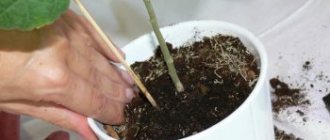These wonderful flowers today have more than 500 varieties; they are common in areas of the northern hemisphere, America, Africa, New Zealand, and Europe. They delight the eye for many years with a variety of blue, purple, lilac, pink, white and other colors. The sizes of violets vary from the smallest to the largest.
Choosing a variety for planting
Among the varietal variety of viola, the most popular varieties and forms are:
- with spectacular bright colors - single-color, two-color and spotted;
- unpretentious in care and resistant to diseases.
Wittrock violet has many shades.
Based on these preferences, it is recommended to choose varieties for growing viola seedlings in a greenhouse:
- "Alpensee" - blooms with dark purple large flowers with a yellow eye - the contrasting petals of this flower have a characteristic mark in the form of cilia.
- “F1 Cristal Bowl White” - large flowers - about 10 cm in diameter, white with a mark in the form of a yellow eye and a wavy edge of the petals.
- "Delta Pure Deep Orange" - flowers of orange color without o - yellow flowers with a diameter of over 6 cm, have a mark in the form of a purple spot on the lower petal.
- “Majestic Giant II Scherry” - flowers about 10 cm in size, pink-cherry in color with a dark cherry spot in the center, may have a yellow rim.
- "Maxim Marina" - purple-white flowers with a purple spot in the center and a yellow eye.
In addition, the varieties “Pure White”, “Reingold”, “Skyline Orange”, “Tangenne”, “Four Seasons”, “Lemon Violets”, “Rippling Waters” have excellent decorative qualities.
Most often, Wittrock violet has many shades and is used to decorate flower beds.
How to plant Wittrock violet
Particularly valuable Wittrock violets can be propagated in greenhouse conditions by layering and cuttings, but the most popular method of propagating this flower is the seed method.
To grow Wittrock violets, it is recommended to choose fertilized loamy soil with a neutral reaction, which should be pre-steamed or treated with a solution of potassium permanganate and well moistened. You can also plant seedlings in a soil mixture consisting of equal proportions of garden soil, humus and peat. There are 2 common methods of planting violas - deep into the ground and surface.
Germination of Wittrock violet seeds
- In the greenhouse, viola seeds are sown from January to March; in addition, autumn sowing of seeds is also practiced. Seeds sown in furrows, at a distance of 1-2 cm from each other, should be sprinkled with peat, sand or soil on top, and moistened with a spray bottle. The width between the furrow rows is 1 cm. Cover with polyethylene. Twice a day, the film should be opened for 10 minutes to remove any condensation that has formed. During this period, the temperature inside the greenhouse is 22-25° C. After 1-2 weeks, shoots will appear.
- Another way to effectively plant viola seeds is to sow them superficially, without planting them in the ground. To do this, spread violet seeds 2 cm apart from each other on the surface of well-moistened soil. Cover with dark film, which should be opened slightly every day to remove condensation. With this sowing method, seedlings appear a little earlier.
Attention! As experiments in cultivating Wittrock violets show, it is best to grow its seedlings using peat tablets. They are rich in nutrients, retain heat well, and do not retain water. Thanks to all these qualities, peat tablets provide a high degree of survival of viola seedlings. To grow seeds, the tablets should be kept in water until they swell, and then the seeds are placed on top of them and lightly covered with soil.
Winter planting of Wittrock violets blooms in late May-early June, if the seeds are sown in March, flowers will appear at the end of summer, summer planting of seeds ensures abundant flowering of the viola in the spring.
Violet shoots
Greenhouses for cuttings, children and adult plants.
I want to share my experience in using various greenhouses. This year, about 100 varieties of violets have been added to my collection, most of which are mini and semi-mini. A lot of greenhouses were needed. When choosing them, I paid attention to both appearance and ease of use.
Buckets made of transparent plastic with a rectangular bottom turned out to be very convenient to use, in the form of greenhouses. They hold 11 pots 5; 5.5 or 100g. cups. The height of the bucket allows you to place planted cuttings or babies. I place the pots in two rows of 4 pieces each. Between them you can place another row, in a canopy, without moving it to the bottom. The lid closes tightly. For constant micro-ventilation, I hang a paper clip on the bucket, then the lid does not close tightly and there is no musty air inside.
A row of such buckets looks very neat on a rack. They are also very stable in vertical columns of several buckets. There is another advantage - they are very durable and will last you a long time. You can buy them in disposable tableware stores.
I really liked using disposable shower caps and similar, but smaller in diameter, lids for food products for greenhouses. They are made of transparent polyethylene. Pack contains 9 pieces of 3 different sizes. The price of the package is 35 rubles.
The packaging of the caps looks like this:
Thanks to the elastic band, such a lid can be selected for any container, and you don’t have to worry about tying the laces. The smallest hat can be placed directly on a pot with a planted plant.
I really enjoyed using the shower caps with the clear cake pans. This design can accommodate 16 pots. The elastic band of the cap fits well to the walls of the cake maker, but due to the ribbed walls there is micro-ventilation and excess moisture does not accumulate on the internal surfaces.
Various plastic baskets can be used as the basis of the greenhouse. But in this case it is necessary to cover the holey walls with a cap. After rooting, you can remove the cap and leave the cups with the cuttings standing in the basket.
An adult transplanted plant can also be placed under such a cover-cover. You can use any suitable sized plate as the basis of the greenhouse.
Such shower caps and covers can be purchased at hardware stores and 1000 small items stores.
I invite everyone to share their successful solutions in using greenhouses in the comments.
How to grow seedlings
In the first days after emergence, it is recommended to continue covering the seedlings with film, opening it at least 2 times a day, gradually increasing the duration of ventilation. After a week, the film can be finally removed. Care during this period consists of regular watering, without waterlogging the soil. As soon as the seedlings have 2 true leaves, they can be picked.
Attention! Wittrock's violet tolerates replanting well, so even if the seedling's root system is damaged, it will still take root if, when replanting, it is deepened to the cotyledon leaves.
Deep planting of seedlings promotes the formation of compact bushes and a powerful root system. To increase the bushiness of the viola, it is recommended to pinch it after the 3rd leaf appears.
After the third leaf appears, pinch the violet bushes
Caring for viola involves frequent watering, since it cannot tolerate even short-term drying out of the soil; in addition, it needs loosening and weeding. With the beginning of flowering, the violet should be provided with regular fertilizing with universal fertilizer, every 2 weeks, for example, with a solution of the drug "Agricola-7".
Violets grow quickly, forming compact bushes 10-25 cm high. They bloom profusely - for several months, to prolong flowering, it is recommended to constantly trim wilted buds and elongated shoots.
Attention! If the Wittrock violet begins to bloom less, its bushes can be rejuvenated and stimulated to bloom if they are cut to a height of 12 cm, well watered and fed.
Wittrock violet needs to be watered frequently and abundantly.
Features of growing violets in a greenhouse
Placing plants in a greenhouse
For normal development and growth, violets need to create certain conditions:
- The presence of a constant temperature of the soil and air (see Temperature in the greenhouse - making an automatic regulator);
- During the flowering period, the optimal temperature should be from 20°C to 24°C, during the rooting period - from 23°C to 25°C. The difference between night and day temperatures should not exceed 2°C - 3°C;
- There should be enough light in the greenhouse, but diffused (see Greenhouse lighting, making the right choice). Direct sunlight has a detrimental effect on plants. With a lack of lighting, violet leaves will stretch out, become narrow, and have a faint color. Excessive direct sunlight will cause the leaves to curl underneath, causing sunburn;
- Watering should be plentiful and carried out when the top layer of soil dries, without flooding the center of the flower rosettes. It is necessary to water with warm, settled water (see Automatic watering in a greenhouse: its positive aspects);
- After watering, the soil needs to be loosened and weeded if necessary.
Violet propagation
Propagation of violets
Violets are easy to grow in a greenhouse. This can be done in one of four ways:
- By cuttings. Reproduction in this way is carried out in the spring, after the onset of sap flow in the plant. Wherein:
- A leaf with a stalk or stalk is selected from the second row, however, not the lowest one.
- You need to choose a cutting that is sufficiently mature, not too large, without damage, the length of the stem is from 2.5 to 5 cm.
- The cutting is cut with a sharp knife.
- Planted in the ground, or in water. When choosing an option with rooting in water, the liquid should cover the cutting no more than 1 cm.
- Half a tablet of activated carbon is added to the water to prevent the spread of infection.
- The rooted cuttings are planted in light soil with good drainage.
- When planting the cutting directly into the ground, the plant is covered with a film, but it is necessary to ensure regular ventilation, and it is better to make small holes in the film.
- In a month, shoots will appear on the violet.
- Stepsons. In the axils of violet leaves you can find one additional small leaf, called stepsons. They are usually removed to preserve the appearance of the violets. When breeding it is necessary:
- Wait until 2-3 leaves appear on the stepson.
- The stepson is separated.
- Planted in moist soil.
- Covered with film.
- Left for rooting.
- Children . Such elements differ from stepchildren in the presence of an independent root system and grow separately from the mother plant. For replanting, children with 2-3 pairs of leaves are used. You can plant the daughter plant separately. To do this, its root system is carefully separated, or an already grown plant is cut off and planted in a separate pot;
- Seeds . They are planted in a light, slightly moist substrate, without a strong depression, otherwise they may not hatch. The surface is covered with film or glass with regular ventilation. The soil should always be slightly damp. After 15 days, the sprouts will begin to hatch, and after 30 days, leaves will begin to appear.
Everyone chooses their own method of propagating violets in a greenhouse. But it must be remembered that the method of propagation by seeds is the most difficult and time-consuming. Violet seeds do not germinate very well.
Planting seedlings
Dropping off stepson
Violet shoots from seeds
Planting and replanting violets
Violet is a perennial plant. If a flower is grown in a pot, over time the soil becomes depleted, and the plant requires replanting, without which the violet cannot be left, even when feeding.
There are several reasons for this:
- The soil is gradually compacted;
- Its air exchange is disrupted;
- The soil begins to drain moisture poorly.
These reasons lead to the exposure of violet stems and the appearance of a whitish coating on the soil. The violet must be replanted annually to keep it healthy and blooming well.
Transplantation is best done in the spring, when it is warm and there is a lot of sunlight. But, with artificial lighting, the time of year does not play a big role.
Tip: Do not replant a blooming violet. When the plant blooms luxuriantly, it does not require urgent replanting. But if traces of infection or parasites are detected, regardless of flowering, replanting is necessary.
When transplanting, the following basic rules must be observed:
- Use only a clean plastic pot. You cannot plant a flower with salt deposits in it. Clay and ceramics dry out the soil faster, and when violet leaves come into contact with the edge of such pots, they begin to turn yellow.
- The pot should be larger than the old one, and its diameter should be 3 times larger than the flower.
- The soil for violets is selected only light, well permeable to water and air. Drainage is important.
- When planting, there is no need to deeply bury the violet into the soil. The leaves should be dry, without adhering soil.
- When replanting, the soil in the pot should be slightly moist to make it easier to remove the roots. Dry soil will injure them, but very wet soil will stick to the roots.
- To rejuvenate the violet, when replanting, you need to cut off the lower leaves and several side roots.
The transshipment method can be used for urgent transplantation. In this case:
- Take a large pot;
- A little soil and drainage are poured in;
- A new pot is placed;
- The space between the walls is filled with earth;
- The old pot is removed;
- The flower and soil remain in the new pot.
With this method of transplantation, the earthen lump is preserved on the plant.
Urgent violet transplant
Violet propagation
Growing problems
Despite its unpretentiousness, Wittrock violet is susceptible to some fungal diseases:
- spotting. A fungal disease that affects the foliage of viola, forming dark spots on it. You can get rid of the disease by spraying with antifungal drugs and isolating the affected plants;
- root rot. Plants affected by this fungal disease should be destroyed, and all others should be treated with a fungicide;
- downy mildew. A fungal disease that affects viola as a result of violations of growing technology: evening watering, failure to maintain temperature conditions, water getting on the foliage. You can get rid of the disease using fungicides;
- blackleg. A fungal disease that develops, like downy mildew, as a result of violations of agricultural practices. Affected plants should be removed, the rest should be sprayed with a fungicide or a soda-soap solution.
Growing Wittrock violets in closed ground conditions ensures the production of profusely flowering plants from spring to autumn. Following basic agricultural practices will make growing them simple and enjoyable.
Growing Wittrock violets - video
How to properly use greenhouses for violets
In violet growing, there is often a need to use a greenhouse. You can’t do without it when solving some problems with violets: nursing too weak children, rooting valuable planting material, loss of leaf turgor after transplanting a rosette...
It is also needed when rooting cuttings, newly planted children, and heads of rejuvenated violets. Of course, all this will take root and grow well without a greenhouse, but with it the process goes faster, it seems to me, and somehow calmer or something, more reliable.
The greenhouse also helps me out in those cases when I need to leave for a few days. I simply place everything that is not on the wick in greenhouses, lightly water it and relax quietly while visiting.
Due to failures, when the plants in the greenhouse begin to rot, many, especially novice collectors, abandon the greenhouses. And completely in vain. You just need to use the greenhouse correctly.











